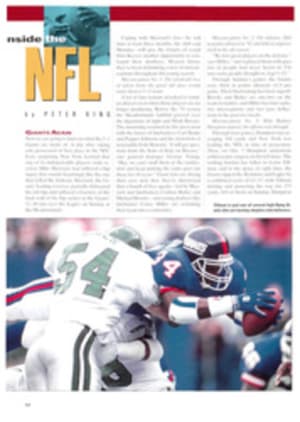
Trickle-Down Economics
Is College Football really so fragile a game that it can't surrender a few scholarships to help beleaguered schools fund women's teams as well as men's minor sports? To hear some big-time football coaches and administrators tell it, such a move would be crippling.
"You can't bite the hand that feeds you," says Michigan State football coach George Perles. "If you cut and cut and cut, your product won't be worthwhile to sell to advertisers."
"They're just going to water it down until it can't compete with the pros for the attention and dollars," says Florida State coach Bobby Bowden. "They're just going to produce an inferior product."
The NFL's New Orleans Saints, warns LSU athletic director Joe Dean, "are only one hour away, interstate all the way."
"Militant women" are out to destroy football, says Father Edmund Joyce, the former overseer of intercollegiate athletics at Notre Dame.
The college game's injury rate chews up so many young bodies that mere talk of a scholarship reduction gets Perles agitated to the point where, he says, "my teeth are sweating."
George. Take a swig of Lavoris and chill. Goodness: afraid of Madison Avenue pantywaists, afraid of not getting enough attention, afraid of a pro team whose fans a few years ago wore bags over their heads, afraid of girls, afraid of spiders 'n' snakes—what are these guys coming to? Where are the stouthearted men such as John McKay, the former USC coach who unilaterally suited up fewer than 50 players during the 1960s and '70s and produced a product so inferior that it won four national championships? "We'll have an offensive team and a defensive team," McKay liked to say. "And the other team will be in charge of carrying me off the field."
Today's football coaches and ADs have been reduced to their desperate caterwauling because the courts are putting heat on schools to finally comply with Title IX, the 21-year-old federal law mandating equitable treatment of male and female athletes. Once upon a time the NCAA treated Title IX as if it were part of some subversive insurgency, but a recent report by the NCAA's Gender-Equity Task Force called for an ultimate goal of participation rates "substantially proportionate" to the number of men and women in the student body. As to how the NCAA would meet that goal, however, the task force demurred, deferring to another task force, this one on cost containment. That was a handoff. But the cost containers failed to recommend any further cut in Division I-A football scholarships from the scheduled limit of 85 in 1994. That was a fumble.
We use the gridiron metaphor because football is the crux of this issue. As colleges struggle in a time of fiscal hardship to belatedly comply with Title IX, it's inexcusable to eliminate a nonrevenue men's sport, such as wrestling or swimming, and blame the women, as many schools are doing. Football can best afford to make sacrifices. If football coaches were to suck it up and stick the same name on the depth chart for third-string right inside linebacker as for third-string left inside linebacker, athletic departments could fund women's and other nonrevenue sports that get lost in the shuffle. After all, if the average Division I-A football scholarship is worth, say, $10,000 a year, five scholarships could pay for a women's soccer program. Perhaps you've seen that College Football Association television spot in which Iowa coach Hayden Fry, chumming up on the couch with Shelley Fabares, a star of the ABC sitcom Coach, asserts that football "frequently" bankrolls women's sports. That might be construed as a chivalrous act were it true, but it isn't. At last count football was losing money at 454 of 524 NCAA schools.
As for the oft-articulated fear that the college game is so brutal that a coach must redshirt tenderfoot freshmen lest they get hurt, we know that's a specious argument when we hear Georgia coach Ray Goff, who recently lost juniors Garrison Hearst and Andre Hastings to the NFL draft, say, "You've got to play the good ones right away because you might not have them for four years."
You won't read here an endorsement of a return to one-platoon football, even though it seems fairly certain that if a latter-day Paul Hornung were to come along—a guy who could rush, pass, block, placekick, punt, tackle and intercept on a single afternoon—the hyperspecialized NFL (which, by the way, limits its teams to 47 players and somehow survives) would suffer in the comparison.
A further reduction in football scholarships—the first limitations came in 1973 when a 105-scholarship cap was introduced—would probably bring more parity and thus more prosperity to the major-college game. "The smaller teams will keep getting better," moans Bowden. "They'll get the players we can't get." Precisely.
Title IX is the law of the land, but it has languished largely unenforced. Now the public wants to see compliance. A recent poll of Georgians conducted for The Atlanta Journal-Constitution showed only 33% opposed to dipping into football budgets to fund women's athletics, even if that meant cutting back football scholarships. Last time we checked, Georgia loved its football and was hardly a hotbed of militant feminists. Eliminate 20, 15, perhaps only 10 scholarship players, and fans will still show up and tune in.
I know I wouldn't miss a handful of young men who weren't going to play anyway. You wouldn't miss them, either.
PHOTO
LANE STEWART

